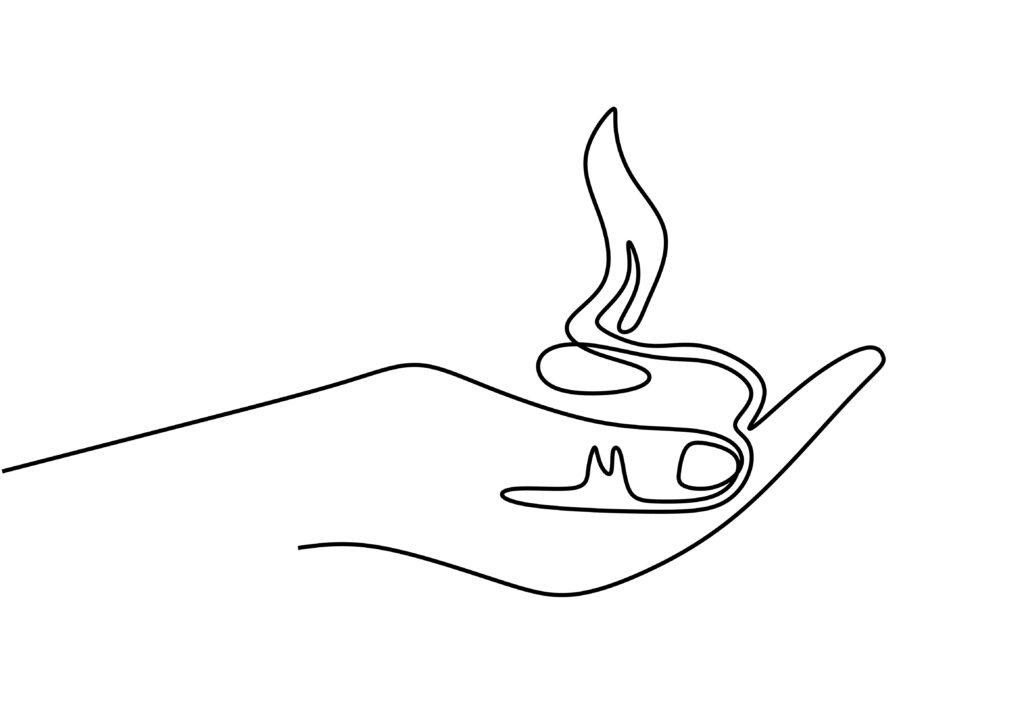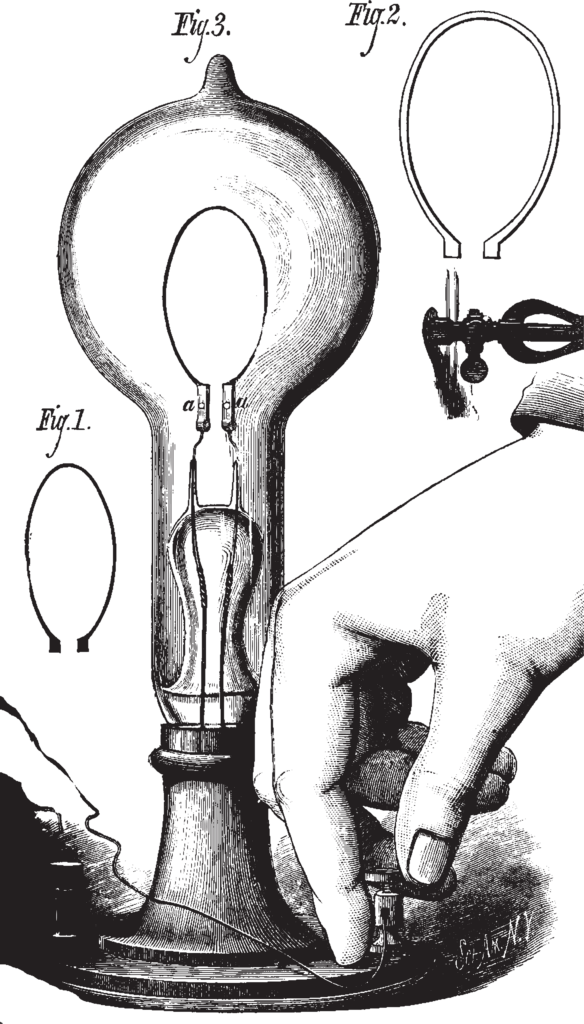Illuminating History

Illuminating our homes today with an effortless flip of a switch, a swipe on the phone or the wave of an arm is rarely an awe-inspiring moment, but perhaps it should be. The history of illumination is long. It encompasses a wide range of fields, from optics to electrical engineering and physics to materials science. From the discovery of fire to the creation of the light emitting diode, better known as an LED, advances in illumination have transformed the human experience.
“We are striking it big in the electric light, better than my vivid imagination first conceived. Where this thing is going to stop lord only knows.”
– Thomas Edison
Early Lamps and Candles
Man first made fire a half-million years ago, but lamps didn’t arrive until the Ice Age, over 40,000 years ago during the Pleistocene era. Humans burned animal fat in the cavities of limestone slabs, using lichen or moss for a wick. Because limestone is a poor conductor of heat, people could easily carry the lamps from place to place, giving man portable light.
For centuries, oil-burning lamps were a popular source of light. The Greeks and Romans refined them with enclosed reservoirs that protected the oil from dirt and insects, but the flame itself was still unguarded.
From about 200 BC to the 1800s, candles made of wax or tallow provided the primary source of light. Romans fashioned the first beeswax candles. Prized for burning evenly, people could tell time by how fast the candles melted. The Roman Catholic Church and the wealthy were the primary users of beeswax, while common folk made do with candles made from tallow. Animal fat was the main source of tallow, but many resorted to any household grease available.

Of course, candlelight wasn’t perfect. People devised ways to brighten what little light they had, like setting a container of water in front of the flame, but even with that the light remained insufficient. In the 13th century, the French Book of Trades forbade goldsmiths and silversmiths to work after dark for “light at night is insufficient for them to ply their trade well and truly.”
Shetland Islanders had perhaps the most interesting light source: the petrel, a seabird full of buoyant, insulating oil. “When the islanders needed a lamp, they would affix a petrel carcass to a base of clay, thread a wick down its throat and set it alight,” Jane Brox wrote in Brilliant: The Evolution of Artificial Light. Aside from the fire hazard and the odor, the idea was practical enough. No oil for a lamp, no wax? No problem. Burn a bird.
A New Status Symbol
The new availability of light separated the country from the city and the poor from the privileged. Since day could be extended into the night, rising late became a mark of prestige. The hours of markets shifted; the nights became lively or even rowdy. Theaters offered evening productions with footlights and spotlights using tallow candles, oil lamps, or torches. The lighting control was done by a snuffer. If a candle burned out or a lamp wick needed trimming, the production would stop and the stage manager would shout, “Snuffer!” Adjustments would be made, and the show would go on.
The well-to-do who dined out and attended these performances exited onto dark or dimly lit streets. Torchbearers, or linkmen as they were known, would roam the streets crying, “Here’s your light!” The linkmen, the 18th-century Uber, did a brisk business lighting the way for the wealthy to their doors. But by the middle of the century, the linkmen disappeared as oil lanterns, casting light downward and outward, lit the streets and made nightlife safer.
Tinkering with Gas
In 1801 in Paris, French engineer Phillippe Lebon demonstrated the Thermolamp. This gas light provided soft light, and heat without sparks or soot. He outfitted his home with Thermolamp lights and charged the curious admission to view them. But few were persuaded, and the Thermolamp ended with him.
Contemporarily, engineer William Murdoch was inventing a system to distribute coal gas. His system stored distilled gas in large tanks with outflow pipes that would send the gas through mains, smaller pipes, then outlets. Like Lebon, Murdoch installed the first system in his own cottage. In 1802, a forge in Soho, Birmingham installed the first commercial system.
British machine shops and factories were the first to upgrade to sustained gas lighting. The previous candles and oil lamps made precision work difficult during the winter when the workday continued after dark. In additional, coal gas burned white in ideal circumstances, thanks to its almost complete combustion. The whiter, clearer flame was superior to the reddish orange glow from oil lamps and candles, whose wicks restricted the amount of light produced.
By the early 1820s, gas streetlamps became common. In London, hundreds of miles of underground gas mains supplied thousands of streetlamps throughout the city. In the U.S., Boston had been the first city to adopt gas lighting in 1817. There was a perception of safety from a brighter light that could eliminate shadows and provide better visibility.
Residential gas lighting was trickier. Burning gas consumed oxygen and created soot and acid residues that ruined fabrics and wallpaper. If rooms were not properly ventilated, people complained of headaches or could even be overcome by carbon monoxide.
Gas lighting also provided a new way to control light: the switch. There were no candles to replace, oil reservoirs to fill, or wicks to trim. Instead, the switch could turn on the flame, adjust its size or extinguish it. The light did not flicker or waver, and it shone both upward and outward for maximum brightness.
Gas lighting required an interconnected system of underground pipes. A meter measured the amount of gas a household used, and the resident paid by the cubic yard. Of course, not every household could afford to have gas piping and lights installed. Many homes, especially in rural areas, still relied on candles and oil lamps.
Experimenting with Electricity
Advances in electricity marked the beginning of incandescent lights, requiring no fire. Ancient Greeks knew that wool rubbed over amber produced electrostatic sparks. Around 1600, Dr. William Gilbert developed the electroscope to detect charges while studying the principles of electrostatic sparks. In 1729, English scientist Stephen Gray discovered that electricity could be conducted from one location to another and also studied the substances that could conduct or resist electricity. He found, for example, that a silk cord could conduct electricity for long distances.
Although these materials could conduct electricity, they could not store it. Thus, they were mainly useful for parlor tricks – which caught the attention of Benjamin Franklin and led to his discovery that an electrical charge could be stored in glass.
By the late 18th century, Alessandro Volta, an Italian, developed the first battery. He stacked discs of copper, brass, or silver with an equal number of discs of zinc or tin with moistened cardboard in between them. This created an electrochemical interaction between the wet cardboard and the metals. The charge would last only as long as the interaction continued.
Scientists developed larger batteries, leading to the first demonstration of an electric light bulb using a platinum filament in 1802. The filament glowed for only a moment, but it marked the beginning of a new type of illumination.
Your Light Bulb’s Ancestors
Like other great inventions, the light bulb can’t be credited to one inventor. It took a series of small improvements to produce to the light bulbs in homes today. Early bulbs were expensive to produce and had very short life spans. In 1879, Edison perfected a carbon filament that could burn for 14.5 hours and patented his incandescent bulb on Jan. 27, 1880. The first bulb that Edison turned on, in 1879, was installed in Livermore, California in 1901 and is still burning.
Further experimentation produced a bamboo filament that could burn for 1,200 hours and became the standard in Edison’s bulbs for the next 10 years. In 1905 European inventors discovered that a tungsten filament bulb lasted even longer and produced a brighter light compared to carbon filament bulbs.

As the 20th century began, incandescent lighting dominated residential spaces. The early 1900s also witnessed the rise of decorative lighting fixtures, reflecting the opulence and grandeur of the art nouveau and art deco movements. Elaborate chandeliers, often adorned with crystal or stained glass, became focal points in dining rooms and entryways. Light had moved from just providing illumination to serving as decorative elements as well.
In 1882, Edison had formed the Edison Electric Illuminating Company of New York, which distributed electricity from a centrally located generator. On Sept. 30, 1882, mill owner Henry Rogers began using electricity to light his Appleton, N.Y., home.
But it took time for electricity to become common in U.S. households. From 1920 to 1935, 70% of homes in the cities were wired for electricity, but rural areas were generally left behind. As part of his New Deal to recover from the Great Depression, President Franklin Delano Roosevelt created the Rural Electrification Program. From 1935 to 1955, the number of farms with electricity soared from 10% to 95%, according to the Federal Reserve Bank of Richmond.
Fluorescents and Other Advances
As the century progressed, technological advancements led to fluorescent lighting. Initially used in commercial spaces, fluorescents gained popularity in residential settings. Fluorescent tubes emitted a brighter light and lasted longer than incandescent bulbs. They were often integrated into ceiling fixtures and recessed lighting systems, providing more uniform illumination in larger rooms. CFLs increased energy efficiency and lasted much longer than incandescent bulbs. However, their bulky size and initial warmup period limited their application in certain fixtures.
The mid-20th century saw the emergence of lighting designs influenced by the modernist movement. Architects and designers such as Le Corbusier and Alvar Aalto embraced clean lines, minimalism, and functionality. They incorporated recessed lighting and concealed fixtures to create a sense of simplicity and uncluttered spaces. These designs emphasized the importance of light as an architectural element, blending seamlessly with the surrounding structures.

In the latter half of the century, innovation brought forth the halogen and incandescent-halogen hybrid bulbs. These bulbs produced a brighter, whiter light and lasted longer than traditional incandescent bulbs. Their compact size allowed for more versatile designs, such as track lighting and adjustable spotlights, giving homeowners greater control over the direction and intensity of light.
A Turning Point: LED
The late 20th century marked a turning point in residential lighting with the light-emitting diode (LED). Although new to homes, the optic process on which they are based, electroluminescence, was discovered in 1907 by Henry Joseph Round, a British radio researcher and assistant to Guglielmo Marconi.
In 1961, Robert Baird and Gary Pittman of Texas Instruments patented the first LED, but it was infrared, well beyond the visible light spectrum. Ironically, Baird and Pittman invented their LED while attempting to create a laser diode. A year later, Nick Holonyack, a consulting engineer for General Electric, invented the first visible light LED. He also invented the first light dimmer. From there, a succession of LED types were developed and refined.
LED lighting, initially expensive and niche in application, gradually became affordable and widely available for home use. They consume less energy, have a long lifespan, and offer a range of color options. This versatility led to the rise of ambient lighting, accent lighting, and task lighting in residential interiors. Additionally, LEDs provide greater design flexibility, as they can be manufactured in various shapes and sizes, allowing architects and designers to experiment with innovative lighting concepts.
What’s Now and What’s Next
Today, we live in an era of smart lighting. Homeowners control their lighting systems remotely via smartphones and voice commands. Integrated systems allow for personalized color temperature, brightness, and even dynamic color-changing effects. Lighting is a tool to enhancing the design and functionality of living spaces. It is an integral part of architectural design.
Energy codes and sustainability standards encourage the use of energy-efficient lighting in residential buildings. Many countries are phasing out the inefficient incandescent bulbs and furthering the adoption of DFLs and LEDs.
Human-centric lighting design involves creating environments that align with the natural circadian rhythm, provide appropriate light levels and color temperatures throughout the day, and support occupants’ biological needs to promote overall well-being. Exposure to natural light, appropriate color temperatures, and adequate lighting levels can positively affect mood, energy levels, and mental health. Conversely, insufficient or poor-quality lighting can disrupt circadian rhythm and contribute to negative moods.
Moving forward, I predict residential lighting will see more advancements in LED technology, efficiency, color rendering, and control options. The integration of lighting systems with home automation and the Internet of Things (IoT) will become prevalent, offering seamless and personalized lighting for homeowners.